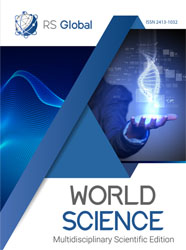INTRAHEPATIC CHOLESTASIS OF PREGNANT WOMEN AFTER THE USE OF ASSISTED REPRODUCTIVE TECHNOLOGIES
Abstract
80 pregnant women were examined after assisted reproductive technology (ART) programs: 40 women with manifestations of intrahepatic cholestasis of pregnant women (IHP) - the main group and 40 women without manifestations of IHP (comparison group).In the majority (62.5%) of patients after ART, the diagnosis of IHP established after 30 weeks of pregnancy. Some patients (27.5%) reported short-term episodes of IHP up to 24 weeks of gestation. In 17.5% of women, IHP had a severe course. Almost a third (27.5%) of women are over 35 years old. Women with IHP have a significantly higher frequency of allergies in the anamnesis (35.0%), liver pathology (20.0%) and diseases of the gastrointestinal tract (25.0%). In one third of women, IHP developed repeatedly, 42.5% of the main patients indicated a family history burdened with IHP. Almost a third of women (27.5% vs. 12.5%, p<0.05) had a history of polycystic ovary syndrome.The current pregnancy characterized by a high frequency of complications. A quarter of patients (25.0%) had early preeclampsia. In the second half of pregnancy, the threat of preterm birth noted in most women during the manifestation of IHP (60.0%). The incidence of fetal distress in women with IHP was almost 2 times higher than in patients without this complication (47.5% vs. 25.0%, respectively, p <0.05). The frequency of preeclampsia is also higher (40.0%).The vast majority of women in the main group were born by cesarean section (70.0%). Almost half of patients with IHP were premature (45.0%). A third of women (35.0%) had fetal distress in childbirth. In 27.5%, childbirth complicated by bleeding of more than 5% of body weight. The postpartum period was characterized by a 4-fold increase in the frequency of late bleeding (20.0% vs. 5.0%, p <0.05).One case of antenatal mortality noted in pregnant women after ART with IHP. Almost half of the children were born with asphyxia of varying severity (48.7%), with 10.3% diagnosed with severe asphyxia. One third of children were born with a body weight below 2500 g (30.8%). In 74.4% of newborns from mothers of the main group, various disorders of the period of early neonatal adaptation were noted, among which the most prominent were: RDS (35.9%), jaundice (43.6%) and gastrointestinal syndrome (30.8%). The 2-fold increased incidence of hemorrhagic syndrome (17.9%) is noteworthy.
References
Clinical Updates in Women's Health Care Summary: Liver Disease: Reproductive Considerations. Obstet Gynecol. 2017,129(1):236. doi: 10.1097/AOG.0000000000001858. PMID: 28002308.
Lindor K.D., Lee R.H. Intrahepatic cholestasis of pregnancy. UpToDate. 2019.
Wood AM, Livingston EG, Hughes BL, Kuller JA. Intrahepatic Cholestasis of Pregnancy: A Review of Diagnosis and Management. Obstet Gynecol Surv. 2018, 73(2):103-109. doi: 10.1097/OGX.0000000000000524.
Çelik S, Çalışkan C. The Impact of Assisted Reproductive Technology in Twin Pregnancies Complicated by Intrahepatic Cholestasis of Pregnancy: a Retrospective Cohort Study. Z Geburtshilfe Neonatol. 2020, 20. doi: 10.1055/a-1129-7358.
Jiang S, Li L, Li F, Li M. Establishment of predictive model for analyzing clinical pregnancy outcome based on IVF-ET and ICSI assisted reproductive technology. Saudi J Biol Sci. 2020, 27(4):1049-1056. doi: 10.1016/j.sjbs.2020.02.021.
Kawwass JF, Badell ML. Maternal and Fetal Risk Associated With Assisted Reproductive Technology. Obstet Gynecol. 2018, 132(3):763-772
Di Mascio D, Quist-Nelson J, Riegel M, George B, Saccone G, Brun R, Haslinger C, Herrera C, Kawakita T, Lee RH, Benedetti Panici P, Berghella V. Perinatal death by bile acid levels in intrahepatic cholestasis of pregnancy: a systematic review. J Matern Fetal Neonatal Med. 2019, 19:1-9. doi: 10.1080/14767058.2019.1685965.
Gardiner F.W., McCuaig R., Arthur C., Carins T., Morton A., Laurie J., et al. The prevalence and pregnancy outcomes of intrahepatic cholestasis of pregnancy: A retrospective clinical audit review. Obstet Med. 2019; 12(3): 123 - 8.
Geenes V., Chappell L.C., Seed P.T., Steer P.J., Knight M., Williamson C. Association of severe intrahepatic cholestasis of pregnancy with adverse pregnancy outcomes: a prospective population-based case-control study. Hepatology. 2014; 59(4): 1482 - 91.
Feng D, He W. Asymptomatic elevated total serum bile acids representing an unusual form of intrahepatic cholestasis of pregnancy. Int J Gynaecol Obstet. 2016; 134: 343–344. Retrieved from https://doi.org/10.1016/j.ijgo.2016.04.004.
Benyuk S.V., Ventskovskaya I.B., Kovalyuk T.V. 2015. Cholestatic hepatosis of pregnant women. The consequences for the fetus and newborn. Perinatologiya i pediatriya. 1(61):20-23. . (In Ukrainian) doi10.15574/PP.2015.61.20
Kong X, Kong Y, Zhang F, Wang T, Yan J. Evaluating the effectiveness and safety of ursodeoxycholic acid in treatment of intrahepatic cholestasis of pregnancy: A meta-analysis (a prisma-compliant study). Medicine (Baltimore). 2016, 95(40):e4949. doi: 10.1097/MD.0000000000004949.
Views:
333
Downloads:
241
Copyright (c) 2021 Boychuk O. G., Ebae N. E. N., Kolomiichenko T. V., Zhdanovich O. I., Savchenko A. S.

This work is licensed under a Creative Commons Attribution 4.0 International License.
All articles are published in open-access and licensed under a Creative Commons Attribution 4.0 International License (CC BY 4.0). Hence, authors retain copyright to the content of the articles.
CC BY 4.0 License allows content to be copied, adapted, displayed, distributed, re-published or otherwise re-used for any purpose including for adaptation and commercial use provided the content is attributed.











